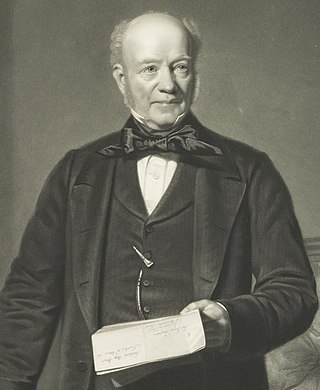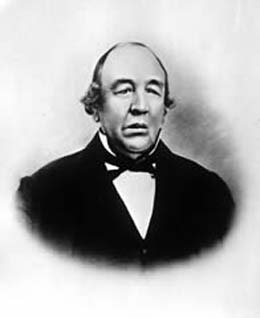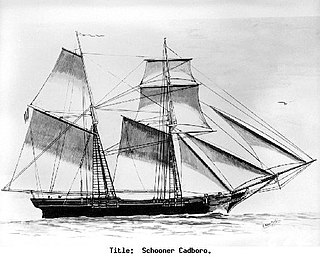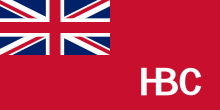
John McLoughlin, baptized Jean-Baptiste McLoughlin, was a French-Canadian, later American, Chief Factor and Superintendent of the Columbia District of the Hudson's Bay Company at Fort Vancouver from 1824 to 1845. He was later known as the "Father of Oregon" for his role in assisting the American cause in the Oregon Country. In the late 1840s, his general store in Oregon City was famous as the last stop on the Oregon Trail.

Sir George Simpson was a Scottish explorer and colonial governor of the Hudson's Bay Company during the period of its greatest power. From 1820 to 1860, he was in practice, if not in law, the British viceroy for the whole of Rupert's Land, an enormous territory of 3.9 millions square kilometers corresponding to nearly forty percent of modern-day Canada.

Peter Skene Ogden was a British-Canadian fur trader and an early explorer of what is now British Columbia and the Western United States. During his many expeditions, he explored parts of Oregon, Washington, Nevada, California, Utah, Idaho, and Wyoming. Despite early confrontations with the Hudson's Bay Company (HBC) while working for the North West Company, he later became a senior official in the operations of the HBC's Columbia Department, serving as manager of Fort Simpson and similar posts.

The first USS Shark was a schooner in the United States Navy. Built in the Washington Navy Yard to the designs of Henry Steers, Shark was launched on 17 May 1821. On 11 May 1821, Matthew C. Perry was ordered to take command of Shark, and the ship was ready to receive her crew on 2 June 1821.

John Work was a Chief Factor of the Hudson's Bay Company and head of one of the original founding families in Victoria, British Columbia. Work joined the Hudson's Bay Company in 1814 and served in many capacities until his death in 1861, ultimately becoming a member of the company's Board of Management for its Western Department. He also served on Vancouver Island’s Legislative Council. At the time of his death, Work was the largest private land owner of Vancouver Island. Work left an important legacy in the form of sixteen journals which chronicle his trading expeditions from 1823 to 1851. His journals provide a detailed record of Pacific Northwest land features, native peoples, and the Hudson’s Bay Company’s fur trading business in the early 19th century.

The Siskiyou Trail stretched from California's Central Valley to Oregon's Willamette Valley; modern-day Interstate 5 follows this pioneer path. Originally based on existing Native American foot trails winding their way through river valleys, the Siskiyou Trail provided the shortest practical travel path between early settlements in California and Oregon.

The Columbia District was a fur trading district in the Pacific Northwest region of British North America in the 19th century. Much of its territory overlapped with the disputed Oregon Country. It was explored by the North West Company between 1793 and 1811, and established as an operating fur district around 1810. The North West Company was absorbed into the Hudson's Bay Company in 1821 under which the Columbia District became known as the Columbia Department. The Oregon Treaty of 1846 marked the effective end of the Hudson's Bay Company's Columbia Department.
The Puget Sound Agricultural Company (PSAC), with common variations of the name including Puget Sound or Puget's Sound, was a subsidiary joint stock company formed in 1840 by the Hudson's Bay Company (HBC). Its stations operated within the Pacific Northwest, in the HBC administrative division of the Columbia Department. The RAC-HBC Agreement was signed in 1839 between the Russian-American Company and the HBC, with the British to now supply the various trade posts of Russian America. It was hoped by the HBC governing committee that independent American merchants, previously a major source of foodstuffs for the RAC, would be shut out of the Russian markets and leave the Maritime fur trade.
Alexander Roderick McLeod was a fur trader and explorer in British North America who began his career with the North West Company in 1802.

Cadboro was a schooner launched at Rye, England, in 1824. The Hudson's Bay Company purchased her in 1826 and sold her in 1860. She grounded just north of Port Angeles, WA in October 1962 and was destroyed by pounding surf shortly thereafter.
Thomas McKay (1796–1849) was an Anglo-Métis Canadian Fur trader who worked mainly in the Pacific Northwest for the Pacific Fur Company (PFC), the North West Company (NWC), and the Hudson's Bay Company (HBC). He was a fur brigade leader and explorer of the Columbia District and later became a U.S. citizen and an early settler of Oregon.
Fort Simpson was a fur trading post established in 1831 by the Hudson's Bay Company (HBC) near the mouth of the Nass River in present-day British Columbia, Canada. In 1834, it was moved to the Tsimpsean Peninsula, about halfway between the Nass River and the Skeena River, and was later referred to as Port Simpson or as the native name Lax Kw'alaams. The fort was part of the HBC's Columbia Department.
Ocean was built in 1808 at Whitby, England, that once carried settlers to South Africa and twice transported convicts to Australia.
Albion was a sailing ship of two decks and three masts, built at Bristol, England, and launched in 1813. She made three voyages transporting convicts to Van Diemen's Land and New South Wales. She also traded with Jamaica, India, and Quebec. For two of the voyages to India she was an "extra" ship to the British East India Company (EIC).
Barrosa was launched in 1811 at Cossipore. She sailed to England and then made six voyages for the British East India Company (EIC); during this period she also made one voyage carrying immigrants to South Africa. After the EIC gave up its maritime activities in 1833-1834, Barossa became a transport. She made three voyages transporting convicts to Australia. She was lost in 1847, without loss of life, while transporting contract labourers from Madras to Jamaica.

Eddystone was launched at Hull in 1802. She then sailed for the North West Company. The French Navy captured her in 1806 but an armed ship of the Royal Navy recaptured her within weeks. She next sailed for the Hudson's Bay Company (HBC) from 1807 to about 1824. She then traded generally until May 1843 when she was wrecked.

Prince of Wales was launched in 1793 on the Thames. She spent much of her career sailing for the Hudson's Bay Company (HBC). From 1845 she was a Greenland whaler, sailing out of Hull. In 1845 she was the last ship to see Sir John Franklin's expedition to the arctic. She was wrecked on 12 June 1849 in Davis Strait.
Actaeon was launched at Topsham, Devon in 1815. She traded widely and from 1823 she made some voyages to Bombay under a license from the British East India Company (EIC). She then traded with what is now Peru, and was probably condemned in what is now Chile in 1828.
Isabella was launched in 1825 at Shoreham. Initially, she traded with Gibraltar and Honduras. The Hudson's Bay Company (HBC) purchased her in 1829 and she was wrecked in 1830 on the Columbia River bar.
Sir George Osborne was acquired in 1814 by British owners purchasing a prize. They initially sailed her as a West Indiaman. Then in 1820 she carried immigrants to South Africa under the auspices of a settler scheme. She then made one voyage as a whaler in the British southern whale fishery. Under new owners she then made a highly unusual voyage to the Pacific. Her new owners were the founders of the Pacific Pearl Fishery Company, and they sailed her on a voyage that was part commercial venture and part scientific exploration, complete with a resident scientist. After her return new owners sent her whaling to the Seychelles, where she was wrecked and abandoned in April 1829.









